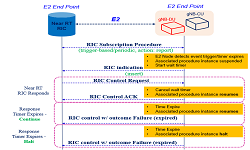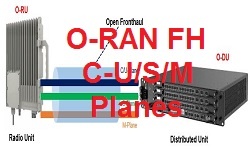O-RAN Distributed Unit (O-DU) Reference Architecture
The O-RAN or Open Distributed Unit (O-DU) is a commercial off-the-shelf (COTS) edge servers that can function as baseband processing unit to handles high PHY layer, MAC and RLC layer with network function virtualization (NFV) or Containers. A simplified picture is shown below explaining how a COTS hardware can be used as O-DU.
The COTS server is first installed with an NFVI layer software which enable to use server resource (Compute, Storage and Network) virtual and shareable for VNFs Application Or kubernetes Pod. On top of NFVI layer the Vendor’s O-DU (Altiostar’s, Mavenir’s, Parallel wireless etc. ) software can be installed and at Top a Orchestration software is required which can manage the underlaying software and hardware for upgrades, scaling and healing purpose.
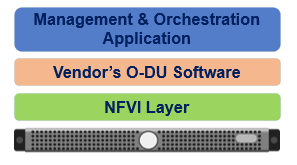
O-DU Requirements and Characteristics
- The O-DU shall connect to multiple O-RUs in the southbound interface (Fronthaul)
- The O-DU shall allow resource pooling for Virtual Baseband functions of high PHY layer, MAC and RLC,
synchronization, OAM, Ethernet, as well as F1 interface function - It shall support technologies e.g. 4G, 5G SA & NSA
- It shall support different 3GPP specified functional splits e.g. 7-2 split
- It shall support synchronization using IEEE1582 v2 or GPS (optional)
- O-DU shall support Linux operating system such as Red Hate CentOS, Ubuntu or similar
- O-DU shall support virtualization with KVM hypervisor or VMware ESXi or similar
- O-DU shall support containerization with Docker, K8s or similar
- O-DU shall allow to use of software features such as DPDK, SRIOV etc. to enhance the performance
- The O-DU shall be designed for both outdoor and indoor scenarios
O-DU Hardware Architecture:
A reference hardware architecture for Open Distributed unit is shown in below figure.
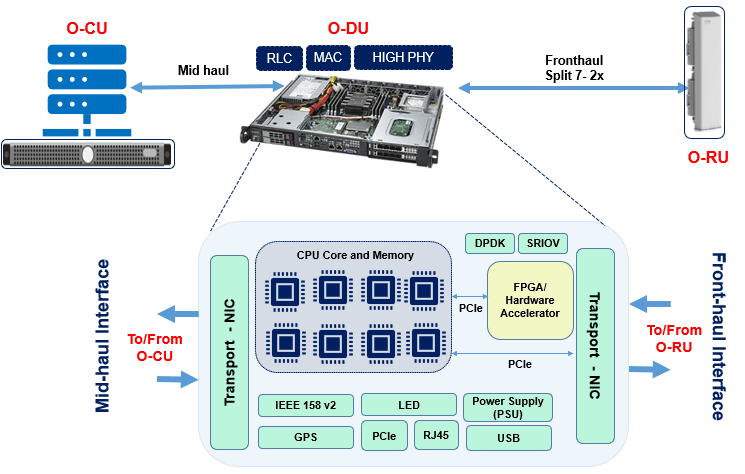
- Synchronization and Transport: GPS/PTP (IEEE 1588) modules can be synchronization, GPS is an option due to limit the hardware cost and complex design. Transport NIC cards are deployed for southbound fronthaul connectivity between O-DU and O-RU and northbound mid-haul connectivity between O-DU and O-RU.
- CPU Core and Memory: The number of CPU core and Memory defines how much VNFs Application can be run on one DU server. These CPU cores and memory are made shared with the help of NFVI software.
- FPGA shall be used to process the FEC function with CPU cores to process the high physical, MAC, and RLC layer and software features such as DPDK, SRIOV etc. cane be used to enhance the performance
- Other Subsystems:
- Power Supply is the heart of O-DU as it drives all the subsystem, Power supply can be AC or DC but recommendation says power supply shall be –48 VDC
- In O-DU, LED can be used for local on/off display Status for Fronthaul/Mid-haul transport interface, Power supply and Radio transmission
- RJ45 Connection can be provided for local access and debug purpose
- USB interface can be provided for local file transfer
O-DU Software Stack and Inter-Connections:
The software stack for RAN node functions in O-DU is shown below. At northbound interface the O-DU connects to O-CU using F1 logical interface and at sound bound interface it connects with O-RU using eCPRI based Fiber interface.
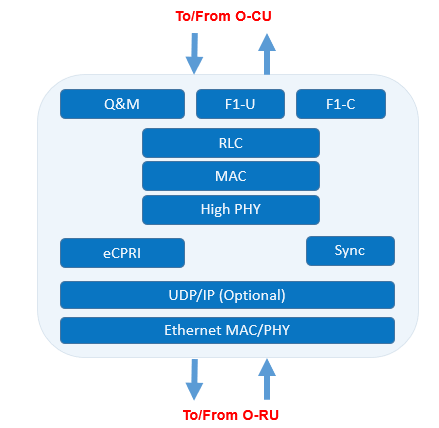
- References
- O-RAN Specification : WG4 – Open Fronthaul Interfaces Workgroup
- TIP Whitepaper
Related Post:


